The Tragic History of L.A.’s Black Family Beach Havens
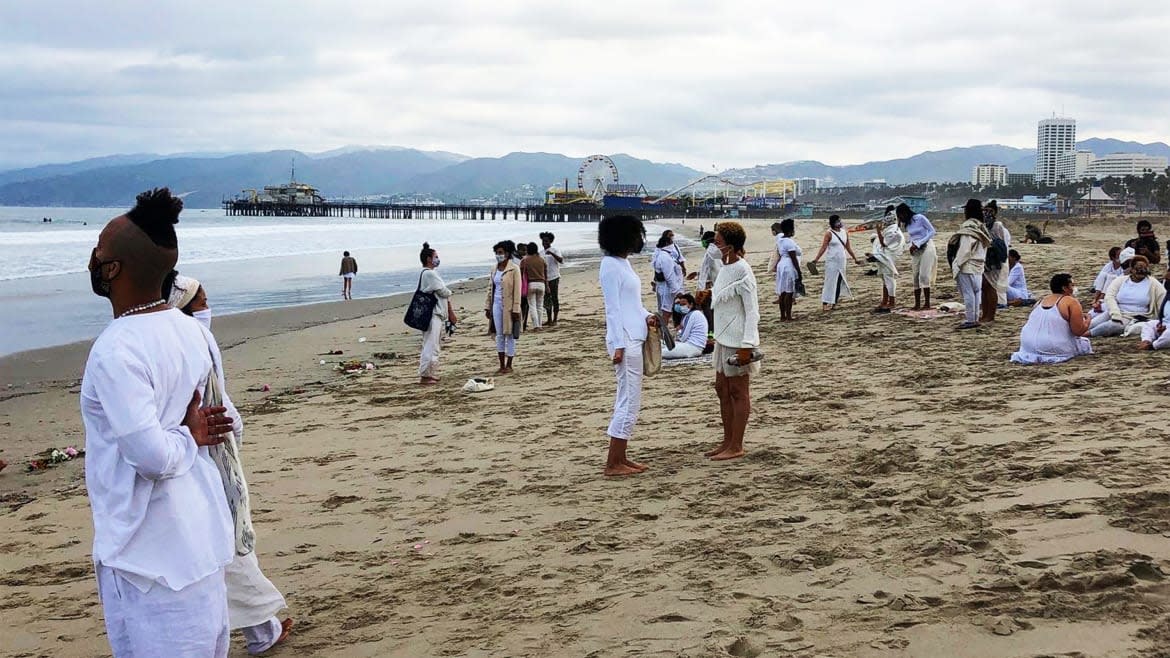
"If we erase from the pages of American history the negro's presence... it would be a short, uninteresting story."— J.L. Edmonds, The Los Angeles Times (1909)
As the sun rose behind Santa Monica’s typically foggy horizon, dozens of Angelenos across race, ethnicity, and generation gathered, dressed in all white carrying vibrantly colored daisies, roses and peonies. We silently filed down to the “Inkwell” beach to honor Black lives lost to state violence. It was only a week after George Floyd’s murder and the uprisings were in full swing, captivating hearts and minds around the globe. Curious locals asked what was going on; some smiled and wished for peace. Older white swimmers in wetsuits maneuvered through us as if we were invisible. Surfers glided or crashed in the distance.
April Banks, Arianne Edmond, and Ali Simon, three Black Angelenos, organized this sunrise meditation specifically at the Inkwell because so few people know about its significance. From the early 1900s until the 1950s, it was a place where African-Americans in Santa Monica could safely enjoy sun, sand, and surf without fear of harassment.
The Inkwell beach, now known as Bay Street Beach, is a 200-foot stretch of coast along the Pacific Ocean only half of a mile south of the famous Santa Monica Pier. The picturesque oasis sits two blocks from the former Belmar community, the first place that African-Americans lived in Santa Monica. It was a thriving area and safe space with Black-owned homes, churches and businesses. But in the 1950s the city took their land through eminent domain to build the Santa Monica Civic Auditorium, which is still there today, dispersing the African-American community across Los Angeles and its suburbs.
“Between redlining and eminent domain Black people are constantly pushed into corners and then losing those corners,” acknowledged Banks, the designer and lead artist for the Belmar History and Art Project, which will celebrate and revive the neighborhood’s legacy through public art. She was commissioned by the city of Santa Monica to do a public arts piece as well as community engagement to document the history from those who have been displaced but still live around Los Angeles.
Banks and Edmonds connected through deep passion and respect for the gathering of Black stories in Los Angeles, especially at a time where rapid gentrification is diffusing our communities. Their individual work aims to educate locals and tourists about the Black roots of the city. For example, did you know that 26 of the 44 “founders” of Los Angeles were Black (listed in historical documents as “Negroes”) and 16 were Indigenous (listed in historical documents as “Indians”) from Mexico? There has been an intentional erasure and whitewashing of this with Southern California textbooks of the 1940s and ’50s (and beyond) depicting these families as white.
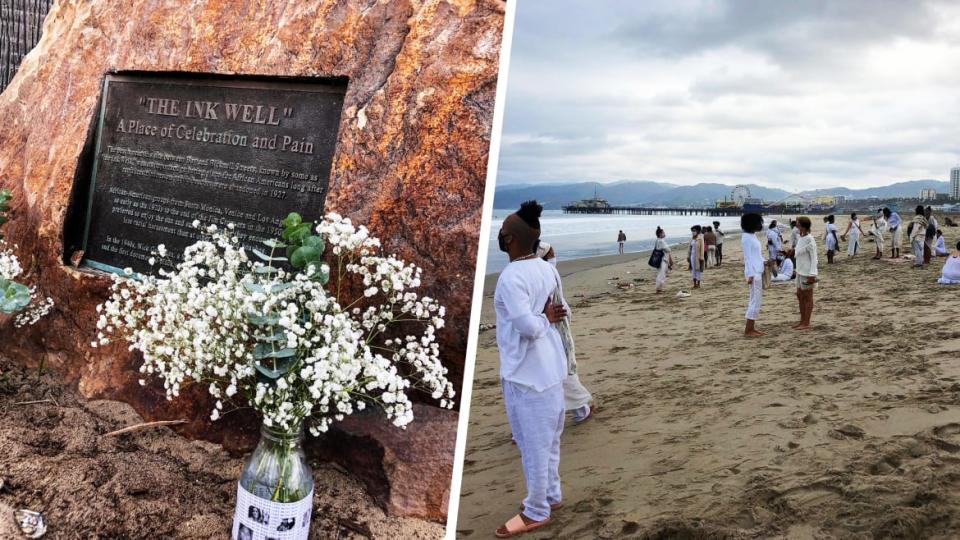
There’s no distinct marker or decorative fanfare acknowledging the Inkwell. A small plaque at the entrance to the beach commemorates it as “a place of celebration and pain.” It notes that even though racial restrictions on beaches legally ended in 1927, the Inkwell remained an important gathering place for African-Americans. The plaque also names Nick Gabaldon, a Santa Monica high school student in the 1940s, the first documented Black and Latino surfer and a local young man who taught himself to swim there. There’s still an annual Nick Gabaldon Day held at the beach in his honor.
“Because of this meditation, people are posting about it (the Inkwell), tagging it, putting flowers by the plaque in ways I’ve never seen growing up,” shared Edmonds whose family has been in Los Angeles for six generations. Her great-great-grandfather, Jefferson L. Edmonds, moved to California from Mississippi with his nine children to escape the blatant and violent racism in the Jim Crow South. He was a newspaper editor and political activist, founding an iconic African-American newspaper, The Liberator, in 1900 and leading it until his death in 1914. She created the J. L. Edmonds Project, in his name, to lift up the legacy of early Black Angeleno life and culture inspired by her great-great-grandfather’s meticulous archiving of every issue he published.
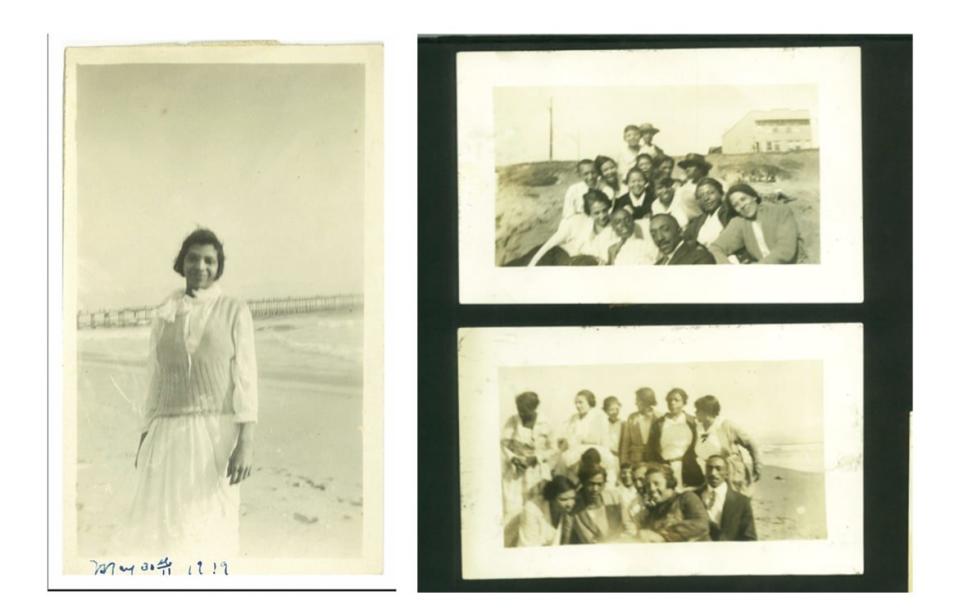
“When I talk to some of the pioneering families in LA, it’s like we’ve been here, they go on with their lives and their families,” said Edmonds. “I haven’t seen this need to fight to prove that we are here. But I think that’s happening now with these younger folks. They are like it can’t be quiet information that you just have in your den or some books.”
Through Edmonds and Banks, I learned about another historic Black beach in Los Angeles County, only 10 miles from the Inkwell. Bruce's Beach, which is part of the City of Manhattan Beach, is another reminder of the parallels of our ancestors and the current realities of Blackness in the United States.
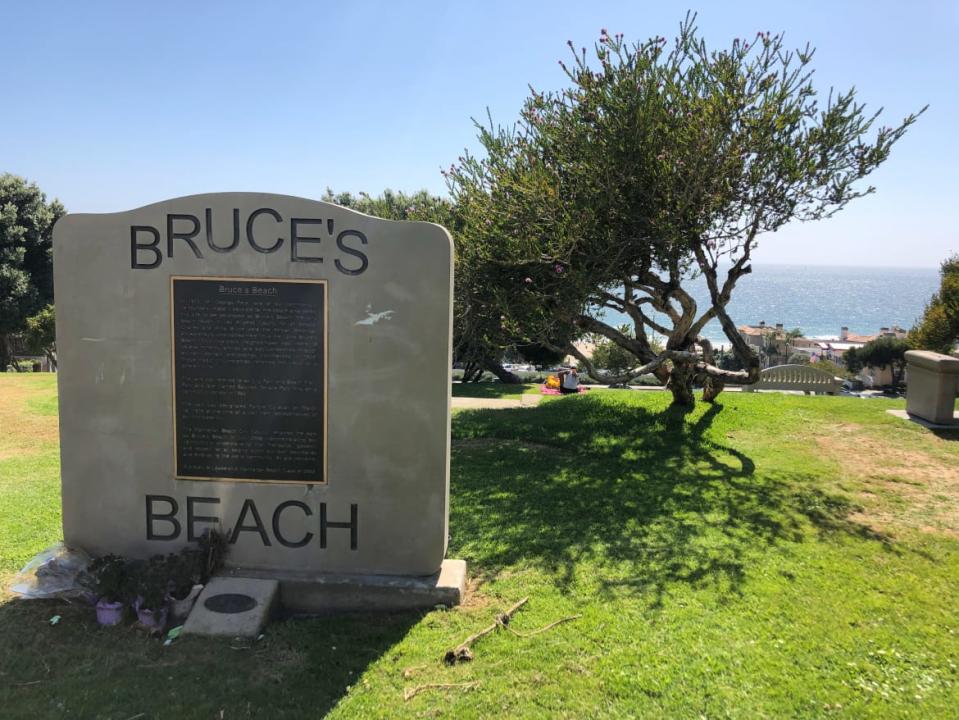
As I walked up to Bruce’s Beach, I was surprised because I’ve driven by many times. It is not actually a patch of sand along the water, it is a grassy sloping park sitting a block above the coastline boasting expansive views of the glistening Pacific. I wondered if the folks sitting on the lawn knew about the history of this land as they shared masked picnics, played with their dogs, and sunbathed. A large plaque commemorating the land sits at the top of the park, facing the sidewalk, with an inscription about the founders and some decaying flowers. The language is vague and doesn’t adequately describe that this Black-owned space was necessary as a place of refuge and joy during the Jim Crow era of segregation. It also omits the role that the Ku Klux Klan had in its demise.
In 1912, two African-American entrepreneurs, Charles and Willa Bruce, moved from New Mexico and bought the land from George Peck, a white pioneer landowner. Peck set aside the beachfront area of 26th and 27th Street in (what is now) Manhattan Beach for minorities who didn’t have access to the beach and the Bruces slowly built a resort. By 1920 more African-Americans moved into the neighborhood and local opposition grew. The plaque fails to note that African-Americans who lived in the two block neighborhood were harassed by white neighbors and active local Ku Klux Klan members who set fires or planted liquor on site during Prohibition to drive them out or get them arrested. It’s even been reported that Peck, who sold them the land, protested against them. In 1924, the Manhattan Beach City Council, which wanted Black people gone, claimed eminent domain for a supposed public park even though they just built Live Oak Park nearby. The Bruces, along with three other African-American families, sued the city, saying that the ordinance was designed to push them out. Three years later Black families still flocked to Bruce's Beach, the only beach where they were allowed, even though police were arresting them as “trespassers.” The resort was torn down and by 1929, the Bruces settled the case for much less than they asked for. The families settled elsewhere, dispersed across a vast city. The land remained undeveloped until the 1950s when local leaders feared that the Bruces’ descendants would claim ownership of the property. It finally became officially named Bruce's Beach in 2006 thanks to Manhattan Beach’s first and only African-American councilman, Mitch Ward, after years of various names and re-naming attempts.
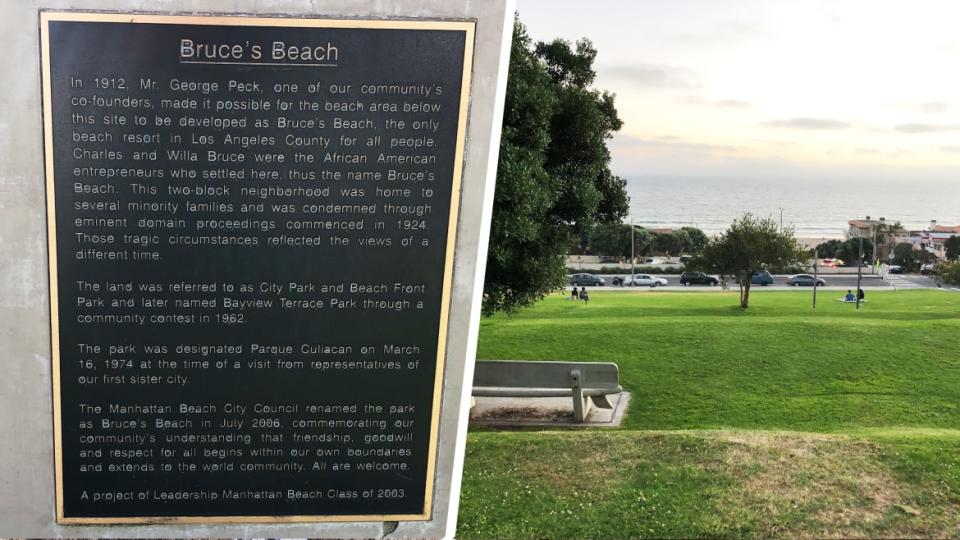
Edmonds visits Bruce's Beach about twice a month and encourages others, especially Black Angelenos and Black Americans, to do so. “This history shouldn't just be in these books. People need to feel this history, people need to step into those shoes a little bit. I have pictures of my family there in 1911, 1914. I want to feel like they may have been pushed out, but not me,” she explains.
“There’s something about walking in our ancestors’ footsteps and showing them who we are now,” said Banks. “Just the thought of that feels so powerful and gives the space itself so much more meaning. I would like to imagine that people now are coming there, to that beach of all the beaches, specifically for that reason.”
During this time of revolution and uprising, and amidst a global pandemic, understanding our collective American story feels more critical than ever. Travel cannot be divorced from the context of the places we visit. There is a countrywide unlearning and reckoning with the revisionist history of the United States, particularly how the contributions of Black and Indigenous people and communities of color have been negated and repackaged in a white supremacist framework. As a travel community, we are learning about the creation of our country and seeking deeper experiences beyond the typical tourist traps or tropes about cities (i.e. LA is merely Hollywood, hiking and Kardashians). Furthermore, we are connecting with the people who make us want to visit these places.
“When we think about LA being one of the largest, most important, metropolitan, richest cities in the country and the world, was started by Black and Indigenous people and were erased from the history…,” Edmonds asserted, “Not on my watch!”
Get our top stories in your inbox every day. Sign up now!
Daily Beast Membership: Beast Inside goes deeper on the stories that matter to you. Learn more.

